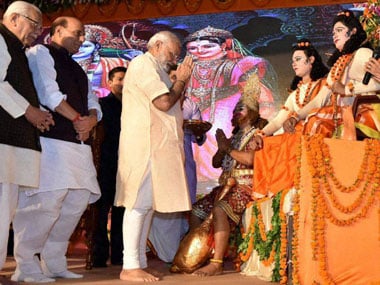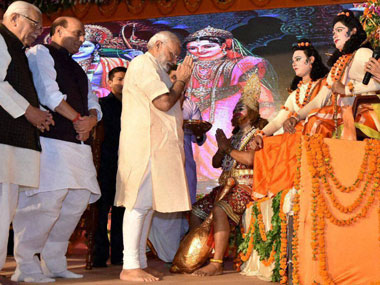Ram Brahma Parmarath rupa, Avigat, alakh, anadi, anoopa! The above verse, borrowed from Goswami Tulsidas’s Ramcharitmanas (the story of Lord Ram), describes the God-incarnate king of Ayodhya as ‘indescribable, unseen, umpteen and unique’. The sixteenth century poet immortalised himself by recounting the tales of Lord Ram in a language that was accessible to the people of Hindi-speaking regions of the country. And just like Tulsidas’s description of Lord Ram’s indescribable nature, Prime Minister Narendra Modi’s full-throated cry of “Jai Jai Sri Ram” on the occasion of Dussehra at Lucknow’s Aishbagh has set the tongues wagging. Which Ram did he refer to? Was it the new 2017 version of Ram for the UP elections et al? But unlike Tulsidas’s unrequited devotion for Lord Ram, that culminated in the creation of the most popular religious text of North India, Modi’s pursuit is in politics and not literature. With the 2017 Uttar Pradesh Assembly elections around the corner, it would not be wrong to view Modi’s chant from the prism of politics. [caption id=“attachment_3046156” align=“alignleft” width=“380”]  Prime Minister Narendra Modi performs aarti of artists enacting Lord Rama and Lakshman during Dussehra celebrations at Aishbagh Ram Leela in Lucknow. PTI[/caption] Nobody can know it better than Modi that bringing Lord Ram and Ayodhya into the political discourse has yielded diminishing electoral returns for the BJP ever since 6 December, 1992 – the day the Babri Mosque was demolished. In all UP Assembly elections since 1993, BJP has found less and less traction with the Ayodhya issue and has shunned the practice of using Lord Ram for electoral gains. In one of BJP’s latest surveys conducted for internal consumption, a senior leader pointed out that the party leadership should shun polarisation lest it would adversely affect the party’s poll prospects in the state. Apparently, the BJP leadership has been dissuading, at times unsuccessfully, its firebrand leaders from stoking fires on communal lines. Although, this should not be taken as BJP’s discovery of secularism as a virtue. Far from it. The party simply regards polarisation as a bad electoral strategy in the present scenario. But then, how can one explain Modi’s full-throated cry of “Jai Jai Sri Ram” in Aishbagh? Perhaps Modi knows it better than most that Ram’s imagery evokes a universality that no other deity can, at least in North India. And his own experience as one of the chief architects behind LK Advani’s Ayodhya Rath Yatra came in handy, helping him understand the deep religio-cultural influence of Ram on the Hindu society across India. By his own admission, Advani was initially a sceptical charioteer who was not quite comfortable with the religious rituals and symbolisms attached with the Rath Yatra. On the other hand, Modi has been quite adept with Hindu rituals right from the beginning and has never shied away from them, even in his role as the prime minister. Recall the manner in which he has been regularly attending rituals of puja in Varanasi and other temples, not only in India but across the world to propitiate the gods. Even in his role as the prime minister, and the head of the country’s political executive, Modi has never been coy about his Hindu identity. But the manner of his chant in Aishbagh was substantially nuanced to mark a difference from the past. Unlike the ‘Jai Sri Ram’ slogans of the 1990s, that stoked riots across Uttar Pradesh, Modi’s cry of “Jai Jai Sri Ram” was borrowed as an extreme devotional expression by the monkey-god Hanuman from the epic TV serial Ramayana. Similarly, his simile of vulture-king Jatayu as the first casualty of terrorism was intended to put across a message of empathy to those belonging to the lower-run of the social order. In people’s perception, Ram found unstinted assistance from this section of the society on his final assault on the demon-king Ravana. But does this kind of symbolism matter during election time? The answer to this question, of course, is not easy. In a deft and astute move, Modi used the slogan at Dussehra to restore the universality associated with Ram. At the same time, he associated himself with a mythology which is the standard-bearer of an ideal social and political life. In his essay on ‘Ram, Krishna and Shiva’, socialist ideologue Ram Manohar Lohia, says, “The story of their lives must not be tested by ordinary standards of plausibility. What can be more plausible than the fact that this story has been engraved on the minds of succeeding generations in India for fifty centuries, probably a hundred." In the Hindi heartland of UP, Ram is firmly entrenched in people’s psyche as a cultural symbol, though there have been many attempts to confine him to religious or casteist grooves. But the magic of Ram’s symbolism has always transcended those barriers. At Aishbagh, Modi carefully tried to appropriate the universality of Ram without referring to the divisiveness attached to it in the recent past. For instance, though Modi described Ram as a symbol of humanity there was no mention of either Ayodhya or the Ram temple. In a deeply religious society such as UP, Ram, bereft of the Ayodhya bickering, would be more of a powerful symbol than a contentious deity. That is the precise reason why Ayodhya remains a peripheral issue for the BJP during these elections. There is no doubt that Modi’s “Jai Jai Sri Ram” chant was certainly not as innocuous a slogan as it was made out to be. But politics is not like literature where even gods can be defined in an easy language, as Tulsidas had done with Lord Ram.
At Aishbagh on Dussehra, Modi carefully tried to appropriate the universality of Ram without referring to the divisiveness attached to it in the recent past
Advertisement
End of Article


)
)
)
)
)
)
)
)
)



